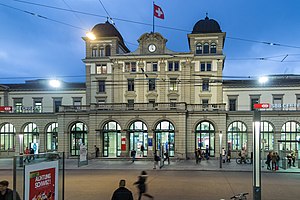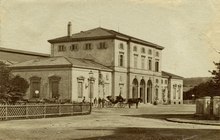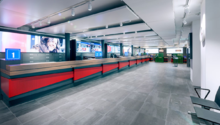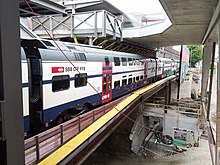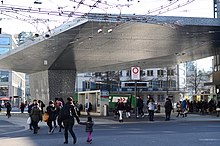Winterthur train station
| Winterthur train station | |
|---|---|
|
Railway station from the north-west
|
|
| Data | |
| Location in the network | Crossing station |
| Platform tracks | 9 |
| abbreviation | W. |
| IBNR | 8506000 |
| opening | 1855 |
| Website URL | www.sbb.ch |
| Architectural data | |
| Architectural style | Neo-renaissance |
| architect | Jakob Friedrich Wanner (1860) |
| location | |
| City / municipality | Winterthur |
| Canton | Zurich |
| Country | Switzerland |
| Coordinates | 696 854 / 261 847 |
| Height ( SO ) | 439 m |
| Railway lines | |
|
|
| List of train stations in Switzerland | |
The Winterthur train station , even Winterthur main station called, is the largest and most important station in the Swiss city of Winterthur . It is operated by the Swiss Federal Railways (SBB) and is the station with the fifth highest number of passengers in the country. The station is served by numerous lines of the Zurich S-Bahn as well as by numerous long-distance passenger rail services. There are also direct train connections to Germany . Most of the trains going to Eastern Switzerland pass through Winterthur station. Notwithstanding the official SBB designation is the train station from the local transport company bus Winterthur whose hub it represents, as a central station called and the Federal Office of Transport in his services documentation out (Didok) under this name.
history
1855 a first provisional originated in Winterthur timbered wood as a station building. The design for it comes from A. Beck, who also took over the construction management. This building was sold to the city of Zurich in 1860, which wanted to rebuild it near the Kornhaus . It is very likely that it was used to build the grain house, as it was very similar.
Five years after the opening of the provisional facility , the first real train station was built under the direction of the architect Jakob Friedrich Wanner , who, together with A. Beck, was also responsible for the design. The master builder Meier came from Winterthur, the railway hall was built by the Benkiser company in Pforzheim . When the Tösstalbahn and Nationalbahn- in Winterthur started operating, the first expansion took place in 1875, with an annex on both sides with the width of four window axes to make space for new waiting rooms.
With the renovation between 1894 and 1896, the station building was given its current appearance. The proposal by the architects Ernst Georg Jung and Otto Bridler , a station building in the Renaissance style , prevailed; the parliament building served as a template.
After horse busses were already in service in Winterthur between 1895 and 1897 , the tram, which opened on July 13, 1898, was the city's second means of public transport. The first route was 1.770 kilometers long and ran as a radial line from Winterthur train station to Töss. Between 1898 and 1951, the station was also served by the Winterthur tram, the two lines of which were linked to one another on Bahnhofplatz between 1915 and 1941. It existed until 1951 and was gradually replaced from 1938 by the Winterthur trolleybus, which still operates today . The responsible transport company was initially the company Winterthur – Töss (WT), which was renamed in 1900 as Städtische Strassenbahn Winterthur ( StStW ) and in 1940 as Verkehrsbetriebe Winterthur ( VW ). Today the company operates as Stadtbus Winterthur .
In 1944, today's tracks 8 and 9 were added. In 1980 the station was again expanded by two tracks (today's tracks 1 and 2), which were used for the Tösstallinie and as a post train track. Today the S-Bahn runs to Wil on the post train track .
In 1988 the two-storey parking deck was built over the rails of the station. In 2000 the construction of the city gate followed Winterthur between the station building and the building of the EPA - department store , which now houses a co-op City is -Warenhaus.
From June 2012, the south station square was extensively renovated and redesigned. Among other things, the bus station was given a distinctive roof ("mushroom"). Work began in January 2013. On Friday, January 25, 2013, the "head" was attached to the mushroom stem in an elaborate action. After two days of work by the scaffolding teams, the new bus station roof on the station square was unveiled later on Sunday afternoon, June 2, 2013, and was visible without scaffolding. Exactly 354 days after the “groundbreaking”, the square with the new roof was officially inaugurated on June 25, 2013 in the presence of guests.
The new SBB travel center at Winterthur station officially opened on Saturday, March 14, 2015.
building
Station building
The station building, which was built between 1894 and 1896, is now used by various companies. These include the Zurich canton police , Starbucks , Jack & Jo and various other companies as well as the tourist information office. In addition to the shops, there are some SBB internal departments in the same building, including the Winterthur travel center, regional marketing for the north-eastern Switzerland region, the financial management of the region, RailClean, Securitrans, the railway police and part of the SBB Real Estate Group. In addition, the SBB station serves as the headquarters for the northeastern Switzerland region .
City gate
In 2000 the EPA department store and the city gate were built next to the station building. The former EPA department store was taken over by Coop in 2002 . .
passenger traffic
In the tourist center of the station the usual SBB services such as national and international Billete be subscription , leisure facilities, event tickets from Ticket Corner , currency exchange and money transfer with Western Union sold.
Other SBB services at the train station include bike rental, luggage lockers, luggage storage, luggage dispatch, and check-in and handling of luggage for SWISS and Edelweiss .
The station has wheelchair-accessible platform tracks, ditto toilets and two counters for disabled people.
Track system
The station is a through station with 9 tracks, of which only tracks 1 and 2 are not continuous. From there, the S-Bahn lines run to the Tösstal and Wil . For long-distance traffic, tracks 3, 4 and 5, which are closest to the station hall, are used.
In front of the station on the route towards Zurich is the former freight station , which was closed in 1995/1996 and is now only used to park trains. The maintenance system at Oberwinterthur station was built as a replacement .
Train traffic
S-Bahn lines
The following S-Bahn lines , which all belong to the Zürcher Verkehrsverbund (ZVV), serve the Winterthur train station. While the lines with the lower numbers are operated by SBB , the trains with higher numbers (from S26) are operated by Thurbo .
- S 7 Winterthur - Kloten - Zurich HB - Stadelhofen - Meilen - Rapperswil
- S 8 Winterthur - Wallisellen - Zurich HB - Thalwil - Pfäffikon SZ
- S 11 Aarau - Lenzburg - Dietikon - Zurich HB - Stettbach - Winterthur - Seuzach / Sennhof-Kyburg (- Wila )
- S 12 Brugg - Altstetten - Zurich HB - Stadelhofen - Winterthur - Schaffhausen / Wil
- S 23 ( Zurich HB - Stadelhofen - Winterthur (- Romanshorn ))
- S 24 Thayngen - Schaffhausen / Weinfelden - Winterthur - Zurich Airport - Zurich HB - Thalwil - Horgen Oberdorf - Zug
- S 26 Winterthur - Bauma - Rüti ZH
- S 29 Winterthur - Stein a. Rhine
- S 30 Winterthur - Frauenfeld - Weinfelden
- S 33 Winterthur - Schaffhausen
- S 35 Winterthur - Wil
- S 41 Winterthur - Bülach
Some relief trains of the S11 that run from here to Zurich are called S23.
Night traffic
Five night lines operate from Winterthur, two of which are assigned to the Zurich S-Bahn network . The other three are “ Thurbo Nightliners”. The SN3 line of the Zurich S-Bahn is operated by Thurbo and is also a Thurbo Nightliner.
-
 1 Winterthur - Zurich HB - Dietikon - Brugg - Aarau
1 Winterthur - Zurich HB - Dietikon - Brugg - Aarau
-
 3 Winterthur - Schaffhausen (- Stein am Rhein )
3 Winterthur - Schaffhausen (- Stein am Rhein ) -
 Winterthur - Romanshorn
Winterthur - Romanshorn
-
 Winterthur - Wil SG - St. Gallen (- St. Margrethen )
Winterthur - Wil SG - St. Gallen (- St. Margrethen ) -
 Winterthur - Bülach
Winterthur - Bülach
Long-distance transport
These regular lines stop at the train station.
-
 ( Basel SBB - Aarau -) Zurich HB - St. Gallen - Memmingen / Kempten - Munich
( Basel SBB - Aarau -) Zurich HB - St. Gallen - Memmingen / Kempten - Munich 


-
 1 Genève-Aéroport - Bern - Zurich HB - St. Gallen BZ RZ
1 Genève-Aéroport - Bern - Zurich HB - St. Gallen BZ RZ



-
 5 Genève-Aéroport / Lausanne - Biel / Bienne - Zurich HB (- St. Gallen ) BZ RZ FZ TT , every half hour, Zurich – St. Gallen every hour.
5 Genève-Aéroport / Lausanne - Biel / Bienne - Zurich HB (- St. Gallen ) BZ RZ FZ TT , every half hour, Zurich – St. Gallen every hour.


-
 8th Brig - Bern - Zurich HB - Romanshorn (
8th Brig - Bern - Zurich HB - Romanshorn (  or
or  ) BZ RZ
) BZ RZ


-
 13 Zurich HB - St. Gallen - Chur partially
13 Zurich HB - St. Gallen - Chur partially
-
 37 Basel SBB - Aarau - Zurich HB (- St. Gallen )
37 Basel SBB - Aarau - Zurich HB (- St. Gallen ) -
 75 Lucerne - Zurich HB - Konstanz BZ RZ
75 Lucerne - Zurich HB - Konstanz BZ RZ
city traffic
The central bus station of Stadtbus Winterthur is located at the main train station in Winterthur , as the Stadtbus train station is called , making it the most important junction for the trolleybus in Winterthur . All but two urban bus lines stop at the train station. The regional lines of the city bus and the PostBus also stop here. Only two lines, one serving Wiesendangen , depart from Oberwinterthur station and one serving Iberg runs from Winterthur-Seen station . Winterthur's bus station is the largest in the canton of Zurich .
City of Winterthur
Lines 1–3 are trolleybus routes . The remaining lines are operated exclusively with low-floor buses. Articulated buses are usually used on lines 1, 2, 3, 5, 7 and 14, while standard buses run on the other lines.
| line | route |
| 1 | Töss - HB - Oberwinterthur |
| 2 | Wülflingen - HB - lakes |
| 3 | Rosenberg - HB - Oberseen |
| 4th | HB - width - HB (circuit) |
| 5 | Technorama - HB - Dättnau |
| 7th | Hegi - HB - Schlosstal - Wülflingen train station |
| 10 | HB - Oberwinterthur station |
| 12 | HB - brother house |
| M. | HB - Oskar Reinhart "am Römerholz" (museum bus; taxi line) |
Regional lines
The yellow numbers are post bus lines, the blue numbers are city bus lines . However, city buses and post buses run on lines 665/670 .
| line | route |
| 660 | HB - Steig - Brütten - Nürensdorf - Bassersdorf |
| 670 | HB - Neftenbach - Berg am Irchel - Flaach |
| 671 | HB - Neftenbach - Hettlingen |
| 674 | Pfungen - HB - Rosenberg - Seuzach |
| 676 | HB - Rutschwil - Henggart |
| 680 | HB - Elsau - Schlatt - Elgg |
Night buses
Night buses are the lines that run every hour from Friday to Saturday and Saturday to Sunday from 1:30 to 4:30. Since the last regular buses usually leave at 0:50 am (from the train station) and the first buses run again from 5:30 am, one can speak of a continuous transport network when the night buses run. The buses only drive the specified lines out of town, but not back.
| line | route |
| N59 | HB - Stlockenbrücke - Schlosstal - Niederfeld - Wülflingen station |
| N60 | HB - Oberwinterthur - Seuzach - Adlikon (Postbus) |
| N61 | HB - Hegi - Elsau - Wiesendangen - Sulz - Rickenbach - Ellikon - Altikon - Thalheim - Dinhard - Welsikon |
| N64 | HB - Rosenberg - Seuzach - Flaach - Buch am Irchel - Riet near Neftenbach (Postbus) |
| N65 | HB - Waldheim - ice rink - Oberseen |
| N66 | HB - Töss - Brütten - Nürensdorf - Bassersdorf - Lindau - Kemptthal |
| N67 | HB - Wülflingen - Neftenbach - Pfungen - Dättlikon |
| N68 | HB - Lakes - Rikon im Tösstal - Turbenthal - Wila (Postbus) |
Expansion and modernization
The current work on and around the Winterthur train station is part of 2 projects. On the one hand, the Stadtraum Bahnhof Winterthur project of the city and, on the other hand, the SBB train station Winterthur project to improve performance .
Urban area of Winterthur railway station
The aim of the Stadtraum Bahnhof Winterthur project is to better connect the old town , Neuwiesen and Sulzer area . The Kesselhaus and Rudolfstrasse, the northern and southern Bahnhofplatz, the two outer pedestrian underpasses and the Archhöfe are affected by the project.
Between 2015 and 2020 the station will be comprehensively expanded and modernized for around 110 million Swiss francs . It is being built on several parts of the station. The northern and southern pedestrian underpasses will be renewed.
The north 4.5 meter wide tiled underpass will be extended to 17.5 meters, there will be shops and a separate underpass for bicycles. The southern pedestrian underpass will also be renewed.
In addition, the bicycle and pedestrian bridge across Wülflingerstrasse will be expanded.
Bahnhofplatz
As part of the project, a steel roof in the shape of a mushroom was built in 2013 for the bus station on the southern part of the station square.
Rudolfstrasse
In a first step, the access road from Zürcherstrasse to the Kesselhaus was closed and a forecourt was filled. After that, Rudolfstrasse was also closed and connected to a continuous square from the boiler house along the train station. The driveway to the parking lot above the railway tracks has been moved to the other side and the two outer pedestrian underpasses are being expanded. The Neuwiesen traffic concept is also associated with the project and the redesign of Rudolfstrasse .
Increased performance at Winterthur station
The technical innovations include a new track section, extended platform roofs and an extended platform for platform 1. The platforms for platforms 6, 7, 8 and 9 will be widened. The expansion will enable new connections between Zurich and St. Gallen and every half hour in the Tösstal between Winterthur and the canton of Schaffhausen .
The SBB have started on 30 August 2015, the works to increase the performance of the station.
The expansions to increase performance will be carried out as part of the 4th partial expansion of the Zurich S-Bahn and ZEB .
Expansion by 2040
In the long term, Winterthur station offers too little space for trains and passengers. It is getting tight on the platforms. For this reason, radical solutions will be sought in the future. We are talking about additional tracks on the sides of the station, a wing, high or low station.
Web links
- Interactive train station map (Winterthur)
- Shops at Winterthur station , formerly RailCity
- Winterthur main station in the Winterthur glossary.
- The SBB in facts and figures 2015
- Expansion of Winterthur railway station , 10ː8 project
Individual evidence
- ↑ SBB: Passenger frequencies at the train stations. In: www.sbb.ch. Retrieved June 1, 2016 .
- ^ Werner Stutz: Railway stations in Switzerland. P. 110.
- ^ Werner Stutz: Railway stations in Switzerland. P. 152.
- ↑ Start of construction for the redesign of Winterthur train station. In: tagesanzeiger.ch/. Retrieved June 1, 2016 .
- ↑ Stadtraum Bahnhof Winterthur - status of the master plan sub-projects
- ↑ Winterthur station is being massively expanded. In: 20 minutes. Retrieved June 1, 2016 .
- ↑ Now let's start with the renovations at the station. In: landbote.ch/. Retrieved June 1, 2016 .
- ^ Expansion of Winterthur train station - 10: 8 architects. In: www.10zu8.ch. Retrieved June 1, 2016 .
- ^ Bahnhofplatz Winterthur in the Winterthur Glossary. Retrieved September 23, 2015.
- ↑ Looking forward to the “twin seats” on the platform. In: landbote.ch. Retrieved June 1, 2016 .
- ↑ SBB: Always up to date. In: www.sbb.ch. Retrieved June 1, 2016 .
- ^ The Winterthur train station is being turned inside out , Zürcher Unterländer on November 16, 2018.
- ↑ Looking into the future at the station , Der Landbote on November 16, 2018.
